The colonialism of Denmark-Norway and its legacies
Overshadowed by British and French Imperialism, the small-scale colonialism of some of the Nordic countries can all too easily be downplayed. From the 19th century, the self-image of the Nordic countries as a group of small, neutral nations has probably perpetuated this misconception. However, Denmark-Norway engaged in a variety of colonial activities throughout the world from the 17th century which still have legacies today. On a lesser scale compared to other colonial powers, its colonialism was characterised by different contexts - some of them brutal - in the Caribbean, West Africa, India and Greenland.
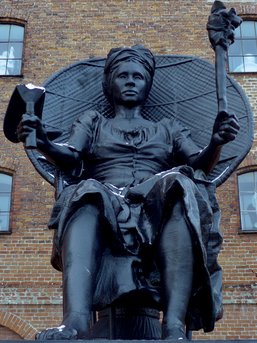
It is rare that the Nordic countries are counted among the colonial powers, but the twin-kingdom of Denmark-Norway did in fact engage in colonial ventures from the seventeenth century. After the secession of Norway in 1814, Denmark continued as a colonial power in the traditional sense until it formally integrated Greenland into the state as a county in 1953. Compared to Britain and France the scale of activities was modest, but in the late eighteenth century colonial trade stimulated significant economic growth, particularly in Copenhagen. While Denmark parted with most of its colonies in the nineteenth and early twentieth centuries, there remains an awareness of past connections through, for example, architecture and historical narratives, and the colonial legacy is actively debated in the US Virgin Islands and Greenland. In Denmark, there have recently been efforts to remind Danes about the colonial past, and to emphasise that even if colonial activities were only conducted on a small scale, they were in essence similar to the colonialism of greater powers.
The building of a small-scale colonial system
Denmark-Norway’s engagement with colonialism might be said to begin in 1618, when King Christian IV dispatched an expedition to Ceylon (Sri Lanka) to form an alliance with the Rajah of Kandy. This initiative was highly influenced by Dutch entrepreneurs, and the goal was to emulate the promising trade of the Dutch and English East India Companies. While neither the treaty nor the trade with Kandy materialised, the expedition resulted in the negotiation of an agreement with the Hindu kingdom of Thanjavur on the Southeast Indian Coromandel coast. This allowed the Danes to establish a trading post by the village Tharangambadi, which the colonisers named Tranquebar. Trading activities from here peaked in the last two decades of the seventeenth century, the main commodities being pepper and cotton textiles. In addition, European and Indian traders from the settlement participated in regional trade across the Bay of Bengal.
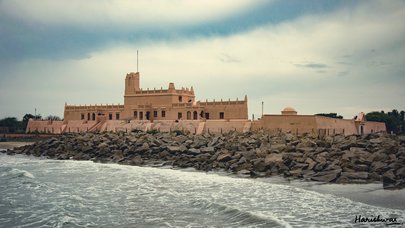
PICTURE: “Dansborg”, locally known as the Danish Fort in Tranquebar, dates back to 1620. The Danish colony there lasted until 1845 when Denmark sold its Indian possessions to the British. The area is still known as Tranquebar in Denmark and many cultural connections exist to this day.Photo: Harishwar, Flickr.
In 1755 Denmark-Norway expanded its presence in and around India. First, the settlement of Serampore (or Frederiksnagore) was established close to Calcutta (Kolkata) in Bengal. Although the area originally granted by the nawab Alivardi Khan was less than a square kilometre, it developed into a dense urban settlement, which in 1800 had approximately 10,000 inhabitants. Second, the first of several failed attempts to colonise the Nicobar Islands was made.
Denmark-Norway entered the Atlantic trading system in the second half of the seventeenth century. Trading forts were established on the so-called ‘Gold Coast’ (present day Ghana) from 1659. Initially the desired African goods were gold and ivory, but from the early 1700s the slave trade became dominant. The Danish presence in West Africa was greatest in the 1780s, when they had six fort-like establishments, the most important being Christiansborg in present-day Accra.
Meanwhile Denmark-Norway occupied the Caribbean islands St. Thomas and St. John (St. Jan) in 1672 and 1718. While white settlers and indentured servants began to establish a diversified plantation economy, the ‘sugar revolution’ soon came to the Danish Islands. The production of sugar received a boost when St. Croix was purchased from France in 1733. Only half the size of Barbados, this Island was larger than St. Thomas and St. John combined and more suited to the cultivation of sugar. Throughout the eighteenth century a slave plantation complex developed on the islands, and Denmark-Norway became a slave-trading nation of some significance. It is estimated that 110,000 enslaved people were transported on Danish ships across the Atlantic from the 1660s to 1803, equalling approximately 2% of the entire Atlantic slave trade in this period. Facing continued economic loss in the slave trade, expecting a British ban and influenced by humanitarian ideas, in 1792 Denmark-Norway decided to prohibit the trans-Atlantic slave trade with effect from 1803. Slavery continued until 1848, when a simmering rebellion forced the governor to declare emancipation of the enslaved population.
From medieval times the Faroe Islands, Iceland and Greenland were dependencies of Denmark-Norway, but contact with Greenland was lost in the fifteenth century. In 1721 an expedition arrived at ‘Haabets Ø’ (Hope Island) on the western coast of Greenland with the double purpose of converting the ‘heathen’ Inuit population and establishing a profitable trade in products derived from sea mammals. During the eighteenth century a string of settlements were established along the western coast of Greenland, and the Danish presence there assumed a more outright colonial character than in the other Atlantic dependencies, which might be seen as settler colonies.
Sugar, cotton and tea
By the late eighteenth century the colonial possessions and interests of Denmark-Norway had reached its peak. Colonial trade through Copenhagen was pivotal to the increasing wealth among the mercantile class in Copenhagen in the period from 1772 to 1807, also known among Danish historians as ‘the period of the efflorescent trade’ (den florissante handels periode).
While trade in sugar, rum, cotton and tobacco from the Caribbean and spices and textiles from India was lucrative, the most profitable branch of long-distance trade was probably in Chinese tea. Until 1784, when the British teas customs were dramatically reduced, it was highly profitable to smuggle tea into Britain. While the China trade cannot be characterised as colonial as such, it was integrated into the colonial system because it was conducted through the Danish ‘Asiatic Company’, which was in charge of the settlements in India until 1777.
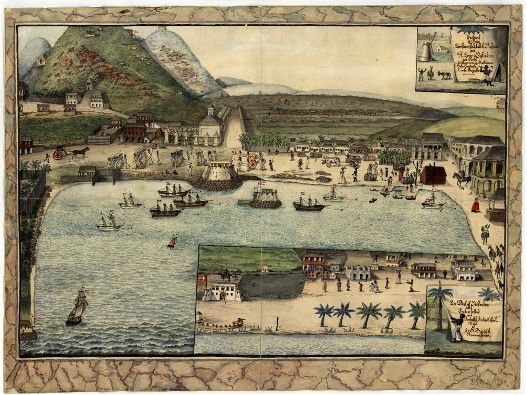
PICTURE: Activity at the harbour in Christiansted in 1815. At that time, it was the most important city and the seat of government in the Danish West Indies. Photo: The Danish National Archives.
The flourishing trade was, however, only possible because Denmark was one of very few neutral trading nations during the War of American Independence (1778-83), the French Revolutionary Wars (1792-1802) and the Napoleonic Wars (1803-15). Colonial trade and the ‘efflorescent’ era came to a virtual standstill in 1807 after the British successfully attacked Copenhagen, seized the Danish-Norwegian Navy, and forced Denmark-Norway into an alliance with France.
Dismantling Denmark-Norway’s colonial system
Following the defeat in the Napoleonic Wars in 1814, the Danish King was compelled to cede Norway to Sweden, and the Kingdom’s role as a medium-sized European power was over. 1814 also marked the end of an expansive – if modest – colonialism. Denmark-Norway had acquired its colonies during the seventeenth and eighteenth centuries for economic reasons. During the nineteenth century Denmark parted ways with its colonial territories, now seen as an economic burden on a much-reduced state. The Indian settlements were sold in 1845 and the African forts in 1850, in both cases to Britain. From the 1860s buyers were sought for the Caribbean islands. Eventually St. Thomas, St. John and St. Croix were sold to the United States in 1917 – following a referendum in Denmark (but not on the islands) – and became the US Virgin Islands.
Greenland was the exception. The reasons for the renewal of the relationship from 1721 cannot be reduced to economics, and throughout the nineteenth century, Denmark consolidated its rule, and even established a presence on the sparsely populated east coast. As late as 1933, Denmark had to fend off a Norwegian claim to parts of Eastern Greenland in the international Court of Justice in the Haag. After World War II, Denmark came under pressure to redefine its relationship with Greenland, as the United Nations tended to define it as a ‘non-self-governing territory’. This resulted in the incorporation of Greenland as a Danish county (amt) in 1953, which meant that Greenland was entitled to have two elected members in the Danish Parliament. While this satisfied the United Nations, relations between Danes and Greenlanders in Greenland were still marked by inequality in fields such as language and salary scales. The bonds between Denmark and Greenland were loosened in 1979 and 2009, as Greenland obtained first ‘home rule’ (hjemmestyre) and then ‘self rule’ (selvstyre). Today Greenland is an independent part of the Danish ‘Rigsfællesskabet’ which consists of the Faroe Islands, Greenland and Denmark. Within this framework Greenland remains dependent on significant funds from Denmark and may not conduct its own foreign policy.
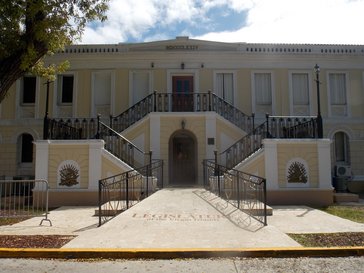
PICTURE: The Legislature of the United States Virgin Islands is located on the island of St. Thomas. It was formerly owned by Denmark, but sold to the United States in 1917. Photo: Wikipedia.
Variety within a small-scale colonial system
An interesting feature of the colonial system established by Denmark-Norway is that it contained variations on the broad concept of ‘colonialism’. In the Caribbean Denmark-Norway based its slave plantation complex on the brutal oppression of enslaved Africans, and there are no indications that the Danes behaved in ways that differed from the larger colonial powers.
In India, by contrast, Demark-Norway was compelled to navigate as a coloniser on terms set by others, namely, first, the indigenous rulers and elites, and later also the major European powers. Relations with the local population were, therefore, ambiguous, and often characterised by negotiation and accommodation to local interests and worldviews. A similar situation prevailed around the slave-trading forts in Africa. Colonialists had to accommodate their actions to shifting configurations of power in the hinterland, and their trade often depended on their ability to create networks and alliances with influential African actors. The existence of large numbers of enslaved people did add, however, a very different dimension to the spectrum of relations between colonisers and the local population. While some sections of the African population were setting the terms for the colonial encounter, others were caught, sold and shipped away in one of history’s most brutal regimes of oppression.
In Greenland a third kind of colonialism developed. As it was difficult for the colonisers to control the sparse and mobile inuit through coercion, they had to use the carrot at least as much as the stick. From the late eighteenth century a particular kind of ‘tutelary’ colonialism developed, in which the Danes saw themselves as the guardians of a vulnerable people, who should not be too hastily exposed to the vices of the modern world. This approach was, it can be argued, the Danish version of the ‘civilising mission’ and it meant that Greenland was effectively sealed off from the rest of the world. Modernist voices from the Greenlandic elite began to question this policy from the 1930s, and when Greenland was occupied by American troops during World War II, American troops brought with them jeeps, jazz and coca-cola. Denmark’s protectionist policy and tutelary colonialism lay in ruins. In a remarkable U-turn, linked to the change of Greenland’s formal status from colony to county, Denmark launched the G-50, a massive plan for the modernisation of Greenland. Over the next two decades, Danish administrators sought to concentrate the population in larger settlements, modernise the fishing industry, and expand educational institutions and health care. From the 1970s, this policy – which gave priority to the Danish language and entailed higher salaries to civil servants born in Denmark, was increasingly contested as ‘neo-colonialism’ and a threat to inuit culture. Today, Greenland’s relations to Denmark and the wider world is continuously being calibrated.
The legacy of Denmark-Norway’s colonialism
In India and West Africa the legacy of Danish colonialism is overshadowed by later British Imperialism, and therefore relatively harder to trace. It is, however, identifiable. Tranquebar was, for instance, home to the first protestant mission in Asia and today the Evangelical-Lutheran legacy manifested in church and school buildings remains visible. All former colonies have seen restoration and conservation projects of colonial heritage buildings, often assisted by the Danish national museum and funded by private foundations based in Denmark. These efforts are obviously linked to a continuing flow of Danish heritage-tourists to the former colonial settlements.
In the Caribbean the period under Danish rule lasted longer, was more oppressive in character and is therefore more contested. In recent decades, there have been repeated demands that Denmark apologise for its involvement in slavery and the transatlantic slave trade. When the centenary for the sale of the Caribbean Islands to the United States was commemorated in 2017, the Danish Prime Minister, Lars Løkke Rasmussen in a speech given on St. Croix, described slavery as “unforgiveable” and as a “dark and disgraceful part of Danish history”; but he stopped short of apologising.
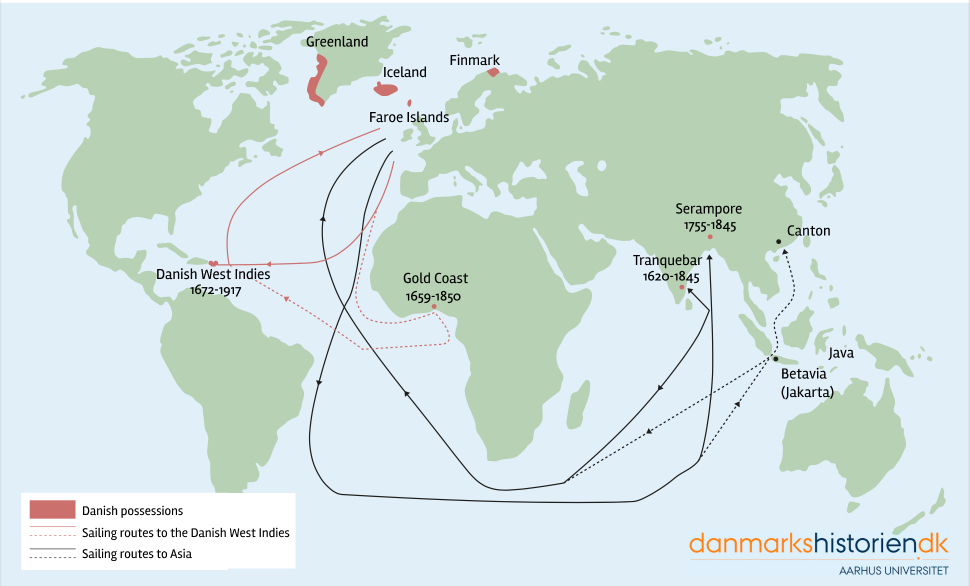
MAP: Danish Tropical Colonies and North Atlantic Monopoly Trade Areas, sailing routes between Denmark and the Tropical Colonies between 1700-1800. (Edited from the Danish version). Permission for use kindly granted by danmarkshistorien.dk.
In Greenland an attempt was made in 2013 to establish a ‘reconciliation commission’ (forsoningskommission) with participation from both Greenland and Denmark. The Danish prime minister, Helle Thorning-Schmidt, declined the invitation to participate declaring “we have no need for reconciliation”. The Commission subsequently had to work as a purely Greenlandic initiative and is an indication that there are still conflicting views on the colonial past within ‘Rigsfællesskabet’.
In Denmark itself, it is often asserted that the colonial past has been written out of public memory, and that its place among the slave-trading nations is neglected. While these allegations are debatable, an influential narrative – which probably emerged in the 1940s – exists that Denmark (and Denmark-Norway) was a relatively benign colonial power. This view was rooted in Denmark’s nineteenth-century transformation into a small peasant-oriented and ‘innocent’ state, its self-image as a benevolent ‘tutelary’ coloniser in Greenland, and the fact that there have been few post-colonial minorities in Denmark itself to contest metropolitan narratives.
In recent years, and culminating in 2017 – when the sale of the Caribbean Islands were commemorated – interest in the colonial past has intensified. Two examples from 2017 might indicate the nature of the interest. First, no less than 29 academics authored a comprehensive five volume colonial history, Danmark og kolonierne, with the declared attempt to write a nuanced account based on the most recent scholarship. The publication was obviously a forceful ‘answer’ to assertions about the neglected colonial past and also an attempt to counter notions about Denmark as a benign coloniser. In another field artists La Vaughn Belle, and Jeannette Ehlers, one based in the US Virgin Islands and the other in Denmark, erected the statue ‘I am Queen Mary’ in front of a warehouse in Copenhagen formerly used for colonial commodities. Queen Mary was one of several leaders of the ‘Fireburn’; a major uprising on St. Croix in 1878 protesting against general living conditions that had hardly changed since emancipation 30 years earlier. The statue is provisional and made of polystyrene, and it is still unclear if it will be made permanent. ‘I am Queen Mary’ represents a strong urge to remember the violence and suppression which also characterised Danish-Norwegian colonialism, and as such it is an argument in an ongoing and important debate.
Further reading:
- Astrid Nonbo Andersen, Ingen Undskyldning. Erindringer om Dansk Vestindien og kravet om erstatninger for slaveriet [No excuse. Memories of the Danish West Indies and the demand for compensation for slavery] (København: Gyldendal, 2017).
- Benjamin Asmussen, Kinafarerne: Mellem Kejserens Kina og Kongens København [The China Traders’ : Between the Emperor's China and the King's Copenhagen] (København: GADs Forlag, 2019).
- Erik Gøbel, The Danish Salve Trade and Its abolition. (Leiden: BRILL, 2016).
- Gunvor Simonsen, Slave Stories. Law, Representation and Gender in the Danish West Indies. (Aarhus: Aarhus University Press, 2017).
- Holger Weiss (ed), Ports of Globalisation Places of Creolisation: Nordic Possessions on the Atlantic World During the Era of the Slave Trade. (Leiden: Brill 2015).
- Lars Jensen, Danmark – rigsfællesskab, tropekolonier og den postkoloniale arv. (København: Hans Reitzels Forlag, 2012.)
- Magdalena Naum et. al. (eds), Scandinavian Colonialism and the Rise of Modernity: Small Time Agents in a Global Arena. (New York: Springer 2013)
- Mikkel Vendborg Petersen et. al. (eds), Danmark og Kolonierne, 5 vols [Denmark and the Colonies]. (København: GADs forlag, 2017).
- Neville A. T. Hall, Slave Society in the Danish West Indies: St. Thomas, St. John and St. Croix. (Baltimore: Johns Hopkins University Press/Mona Jamaica: The University of West Indies University Press, 1992).
- Niels Brimnes, Constructing the Colonial Encounter: Right and Left Hand Castes in Early Colonial South India (Richmond: Curzon Press 1999).
- Pernille Ipsen, Daughters of the Trade. Atlantic Slavers and Interracial Marriage on the Gold Coast. (Philadelphia: University of Pennsylvania Press, 2020).
- Søren Rud, Colonialism in Greenland: tradition, governance and legacy. (Cambridge: Palgrave MacMillan, 2017).